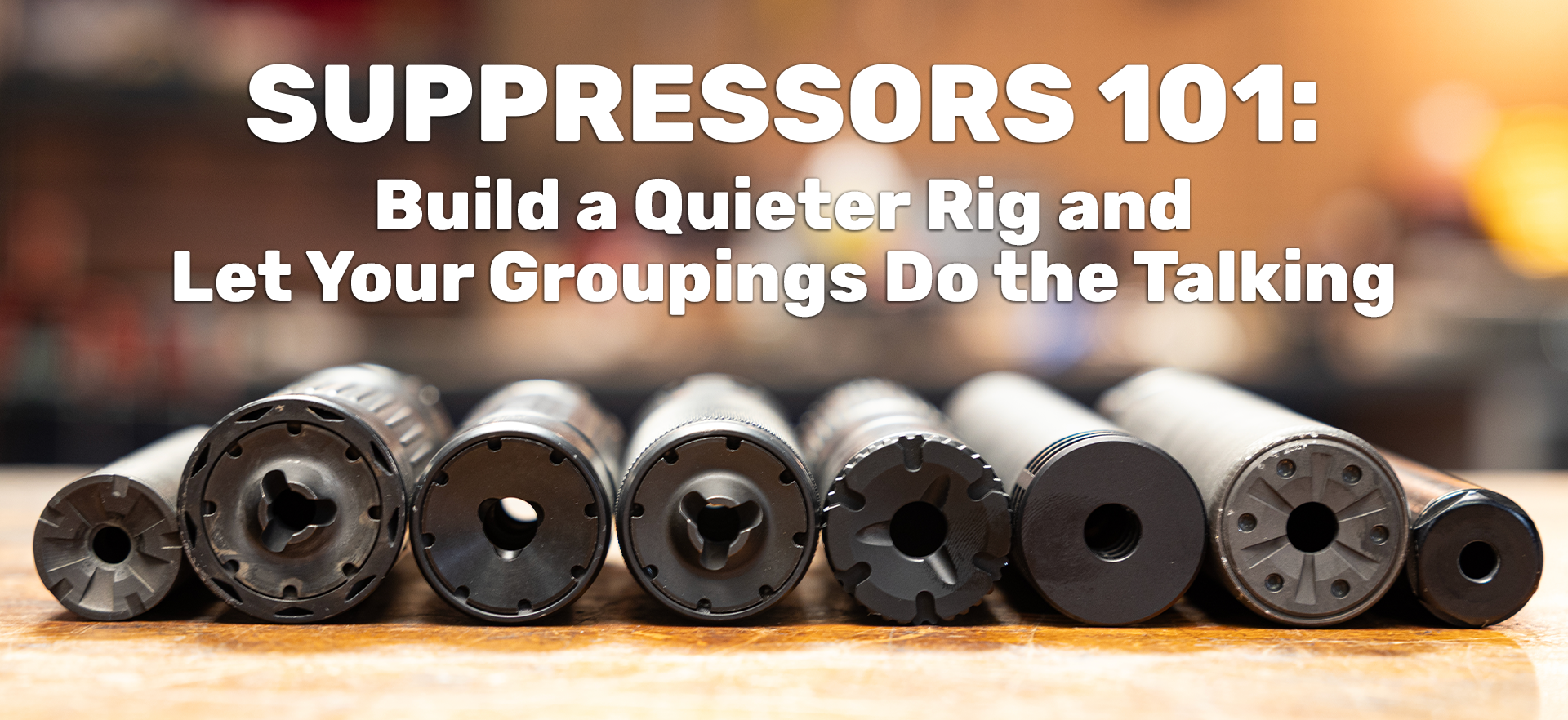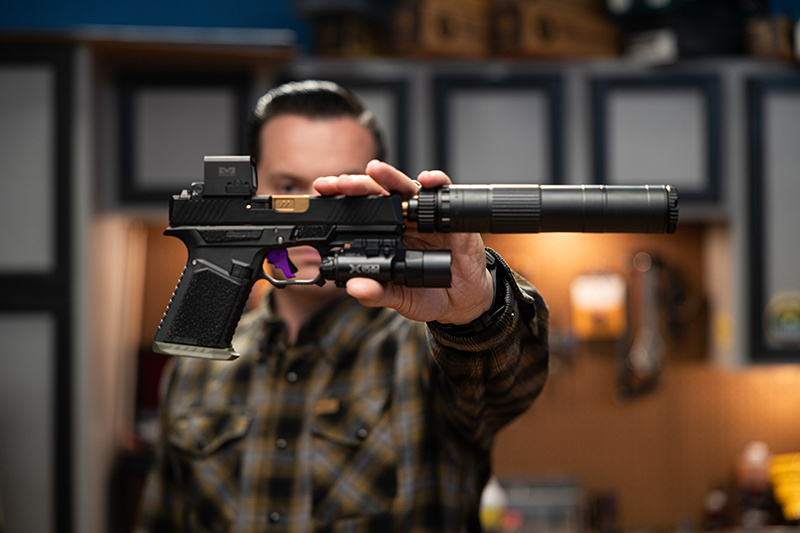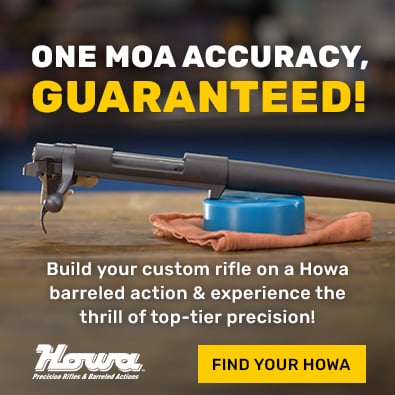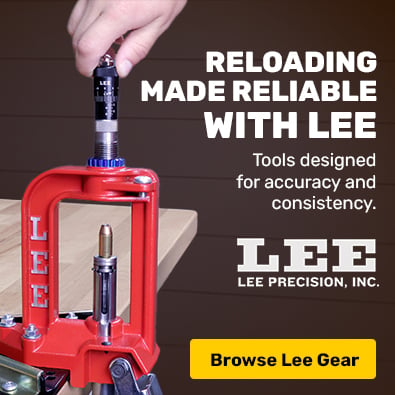Everything you need to know about selecting the right suppressor
Choosing the right suppressor isn’t just about hushin’ up your gun, it’s about getting the most out of every shot you take. When you match the right caliber, thread pattern, and host firearm, you don’t just shoot quieter, you shoot smarter, steadier, and a whole lot better. At Brownells, we don’t believe in half-measures. We believe in getting it right the first time.
Top 5 Reasons to Grab a Suppressor
Some folks think a suppressor’s just for hush. That’s like saying a horse is just for trotting. A good can changes how you shoot. Think, chopping wood before you sharpen your axe.
Here’s what you get when you shoot suppressed:
- Reduced Recoil: Tames your rifle smoother than a seasoned rider calms a colt. Less kick means faster follow-ups and steadier aim.
- Improved Accuracy: A quiet muzzle steadies your shot, tightening groups like a good story holds a crowd. Fewer excuses, more bullseyes.
- Hearing Protection: Save your ears now, so you can grumble at your grandkids properly in your old age.
- Tactical Advantage: Quieter shots keep you hidden, whether you’re stalking game or just keeping your business to yourself. Nobody ever wished for a louder gun.
- More Enjoyable Shooting: Less blast, less headache, more time for jawing with friends over a well-placed shot.
Fire a suppressed shot, and you’ll wonder why you ever endured the racket. It’s like trading a wooden rocking chair for a Lay-Z-boy®, once you know comfort, you don’t go back.
Caliber Compatibility Made Simple
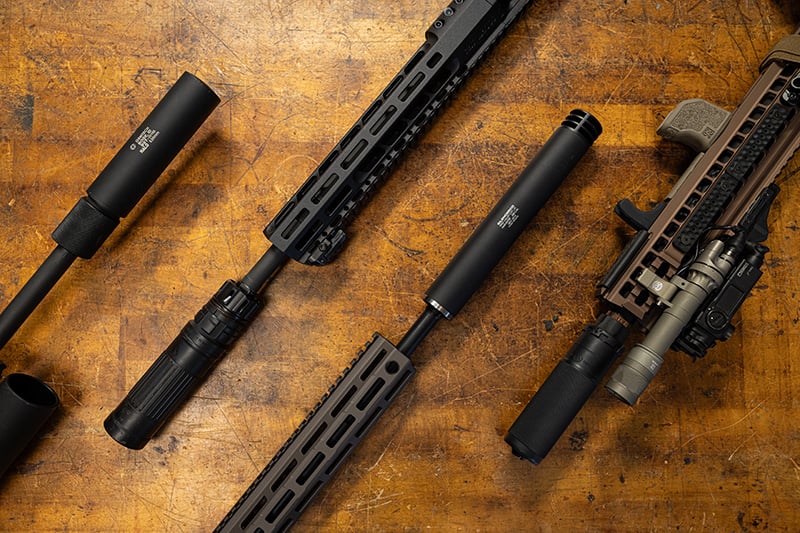
Suppressors are not one-size-fits-all, no more than boots fit every foot. Pick the wrong one, and you could be in for a world of regret. Pick right, and your gear will hum.
Here’s what to factor in:
-
Primary Caliber & Compatibility: What’s your go-to round? A 9mm pistol fan needs a different can than a .308 deer hunter. And make sure the suppressor matches your firearm’s barrel threading. Some suppressors are flexible enough to handle multiple calibers, but always double-check your setup.
-
Suppression Goals: Want maximum hush or minimum bulk? Bigger suppressors usually mean quieter shots, but they also add more length and weight. Find your balance based on your needs.
-
Mounting Options: Most folks choose between direct-thread (simple, reliable) or quick-detach systems (swap fast between guns). Know what your firearm supports, and how quickly you need to make changes in the field or on the range.
-
Intended Use: Different jobs call for different tools. A lightweight can for a hiking rifle, a rugged one for heavy-duty hunting, or a compact suppressor for your home defense setup—make sure your choice fits the mission.
All of this boils down to knowing your gun, knowing your needs, and picking the suppressor that’ll help you shoot quieter, shoot smarter, and shoot better.
Barrel Threads: The Details That Can Easily Be Overlooked
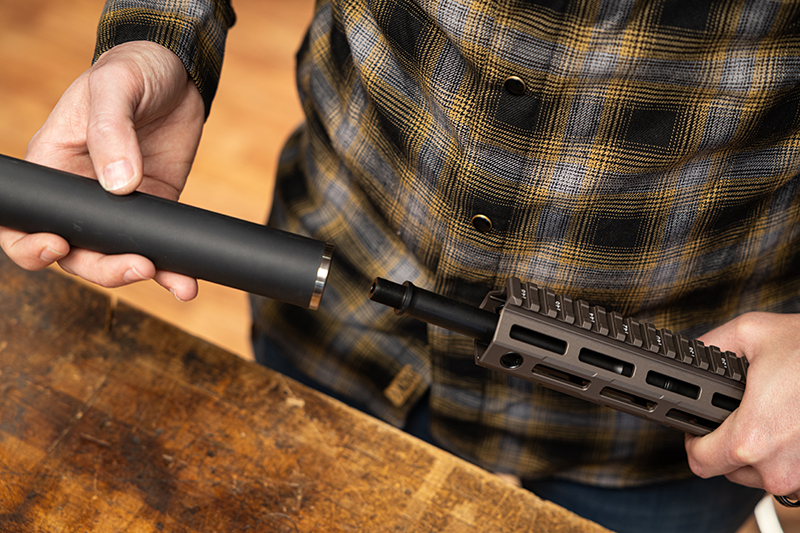
Threads matter! Mismatch your barrel and suppressor, and you’ve got about as much chance of shooting as a cat’s got of whistling dixie. Get it wrong, like slapping a 1/2x28 can on a 5/8x24 barrel, and you’re stuck with a pricey paperweight.
We keep it simple with adapters, converters, and plain talk to get you shooting, not swearing.
Common Threads:
-
1/2x28: The standard for 9mm pistols and 5.56 rifles, trusty as a good dog.
-
5/8x24: The go-to for .30 caliber rifles, like .308 or .300 Blackout.
-
Metric Threads: For when the world gets ornery and measures in millimeters.
Beyond Caliber and Threads: The Rest of the Story
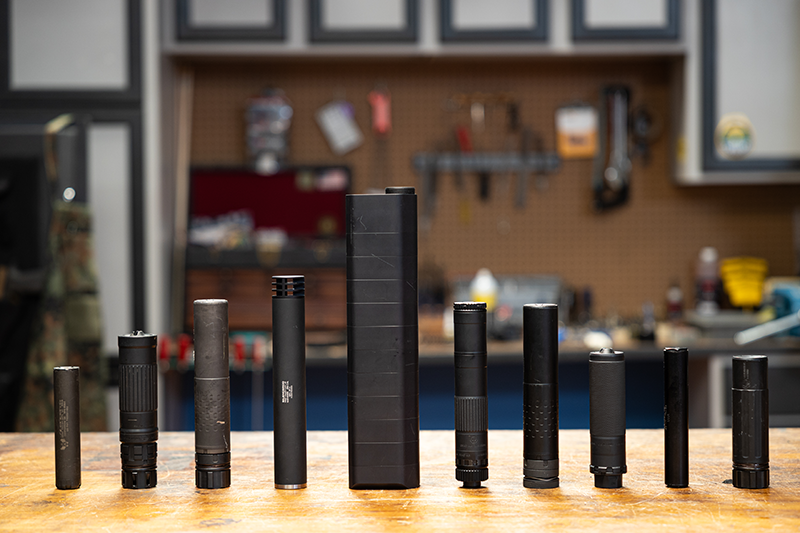
A suppressor’s more than its bore and threads. A few extra considerations keep your build as slick as a riverboat gambler:
-
Length and Weight: Short cans are handy for tight spots, like a home-defense rig. Longer ones hush better but add heft.
-
Material: Titanium’s light but pricey; steel’s tough but heavy. Choose what suits your wallet and your shooting.
-
Mounting Style: Direct-thread’s simple, like a handshake. Quick-detach mounts swap faster than gossip, ideal for multi-gun days.
A Quick Word On The Law
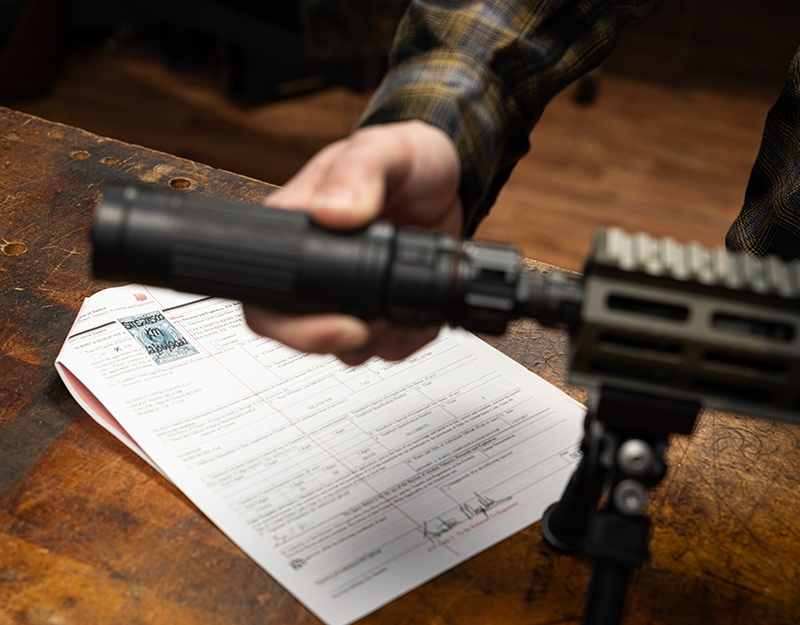
Suppressors and the Law
Suppressors are legal, but Uncle Sam likes his paperwork. You’ll need an ATF Form 4 and a $200 tax stamp, plus a bit of patience while the gears grind. You can register your suppressor as an individual or through a trust—each has its pros and cons depending on your situation and who you want to legally share access with.
*This is not legal advice. We're not lawyers—just folks who know guns. For legal guidance, talk to a qualified firearms attorney.*
We can’t fill out the forms for you, but we’ll point you to folks who know the ropes. Think of it like paying a toll to cross a quiet bridge—worth it for the peace on the other side.
How to Order a Suppressor the Easy Way
Ordering a suppressor doesn’t have to be a mess of forms and frustration. At Brownells, we believe building better includes making the process as smooth as possible, no guesswork, no runaround. Just straight talk, good gear, and a clear path from “want” to “got.”
1. Pick the Right Suppressor for Your Needs
Start with what you shoot and how you shoot it.
-
Caliber & Compatibility: Make sure the suppressor lines up with your firearm’s barrel thread and caliber. Many cans work across multiple platforms, but check twice, buy once.
-
Suppression Goals: Bigger suppressors generally quiet things down more, but they also add length and weight. Think balance.
-
Mounting Options: Direct-thread mounts are simple and solid. Quick-detach (QD) systems offer fast swaps if you’ve got a multi-rig setup.
-
Intended Use: A deer rifle in the woods? A home defense pistol? A .22 for backyard plinking? Different jobs call for different tools.
Need help? Our team can help you double-check compatibility before you commit, or check out our compatibility chart here.
2. Handle the Paperwork (Without Losing Your Mind)
Suppressors fall under the National Firearms Act (NFA), which means a little patience and a $200 tax stamp are part of the deal. But it’s not as complicated as it sounds—we’ll walk you through the steps or point you to folks who specialize in helping.
Here’s what to expect:
-
ATF Form 4: This is your official application to legally own the suppressor. It includes basic info, a passport-style photo, and the suppressor’s serial number.
-
Fingerprint Cards: You’ll need to submit a set for your application. Some dealers offer digital fingerprinting to speed things up.
-
CLEO Notification: The ATF notifies your local Chief Law Enforcement Officer. No approval needed—just a heads-up.
-
Waiting Period: Once approved, there’s a short hold while the paperwork clears all the final hurdles.
Keep a copy of your approved Form 4 and tax stamp on hand anytime you’re using your suppressor. Only the person (or trust) listed can legally possess it.
3. Take Delivery (the Best Part)
Once your paperwork is processed and approved, you can pick up your suppressor from your selected dealer. Some dealers even offer direct-to-door delivery where legal—making things that much simpler.
The whole process takes some time, sure. But the payoff? Worth it. Fewer headaches, quieter shots, and gear that feels built just for you.
Build It With Us
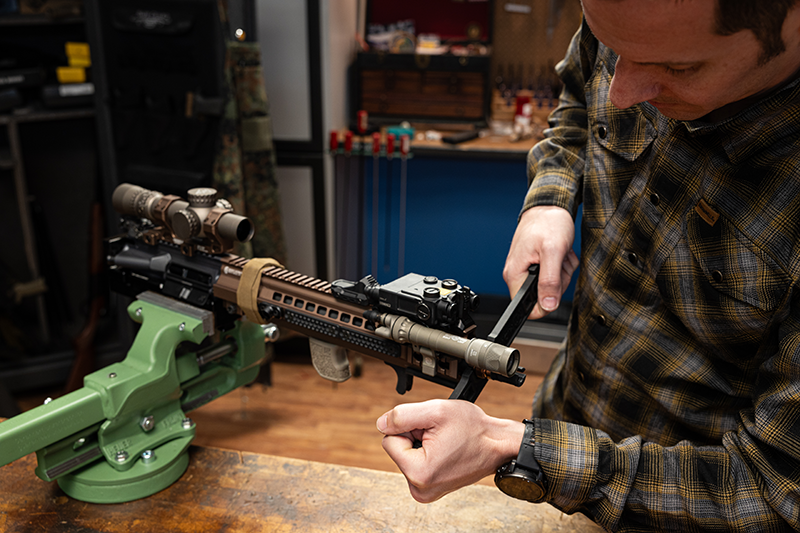
Picking a suppressor is part science, part art, and all common sense. It’s about balance, reliability, and building a rig you’re proud to show off at the range, without explaining “that funny-looking tube” to every passerby.
Whether you’re tuning a long-range tack-driver, rigging a pistol for home defense, or just making range days kinder to your ears, We are your partner in building better.
Ready to Hush Your Rifle?
Let us help you quiet that boom. Learn from our pros, build with confidence, and shoot the way you were meant to—with a whisper and a smile.
Need help? Our team can help you double-check compatibility before you commit, or check out our compatibility chart here.
Shop Suppressors, Mounts & Adapters
Suppressor FAQ: Straight Talk for First-Time Buyers
1. Will a suppressor work on both my rifle and pistol?
Only if you're lucky or smart, and we prefer smart. Most suppressors are caliber-specific and threaded for a particular barrel type. If your rifle and pistol shoot the same caliber and share a thread pattern, you might get away with one can. Otherwise, you’ll need adapters or separate suppressors. Always match your gear like boots to socks, right fit, right function.
2. How quiet is a suppressor really? Will it sound like in the movies?
Not quite Hollywood quiet, unless you're shooting subsonic .22s in a spy movie. A suppressor drops the decibels enough to save your ears and your range reputation, but you’ll still hear a pop, especially with supersonic ammo. Think muffled thunder, not silence. Still, once you hear it, you’ll never want to go back.
3. Can I install a suppressor myself, or do I need a gunsmith?
If you can thread a bolt or change a muzzle brake, you’re halfway there. Direct-thread suppressors spin on easy as pie. Quick-detach setups take a bit more know-how but aren’t rocket science. Just double-check your barrel threading and torque specs, and maybe skip the power tools.
4. What’s the deal with subsonic vs. supersonic ammo in suppressors?
Subsonic ammo stays under the speed of sound, so you dodge that crack you get from a supersonic round. That means way quieter shooting. Supersonic still benefits from a suppressor, but it’s louder. Think of subsonic as sneaking into the woods, and supersonic as knocking politely but firmly.
5. Will using a suppressor mess with my gun’s accuracy or performance?
If anything, it usually improves it. Less recoil, less muzzle rise, and a steadier shot. That said, adding any new gear to a gun can shift point of impact a bit. It’s nothing a quick re-zero can’t fix. Just like tuning a guitar, it may need a tweak to sing right.
6. Do I need a special barrel to run a suppressor?
You’ll need a threaded barrel, sure as a hitch needs a ball mount. Most factory barrels aren’t threaded, but many guns have drop-in replacements. Once threaded, you're good to go, just match the pitch (like 1/2x28 or 5/8x24) and you’re in business.
7. Can I legally travel with my suppressor?
You can, but don’t just toss it in the glove box and head across state lines. Suppressors are federally regulated, and not every state plays nice. Always check the laws in the state you're visiting. Keep your approved ATF Form 4 and tax stamp with you, like a fishing license for quiet.
8. Is the wait for approval really that long? Why all the red tape?
Yep, it takes a minute, or a few months. Uncle Sam doesn’t rush. The ATF Form 4 process, plus fingerprints, photo, and that $200 tax stamp, adds some wait time. But once it clears, the suppressor’s yours for life. Think of it like slow-cooking ribs, takes a while, but oh, is it worth it.
We’re With You Every Step of the Way
Choosing the right suppressor can feel like a lot, but you don’t have to go it alone. Whether you're building your first rig or fine-tuning your tenth, We are here to help you make sense of the options, avoid common pitfalls, and build with confidence.
Our team of experts is ready to answer your questions, double-check compatibility, or walk you through the next steps. Because when you build with Brownells, you’re not just buying parts, you’re joining a community that’s passionate about doing it right.
Got questions?
We’ve got answers. Reach out anytime, we’re here to help make your build smooth, smart, and just the way you imagined it.
Build it better. Build it with Brownells.




